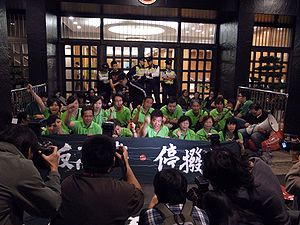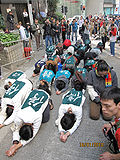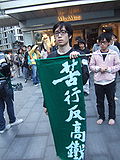- Opposition to the Guangzhou-Hong Kong Express Rail Link
-
Opposition to the Guangzhou-Hong Kong Express Rail Link 
Villagers of the to-be-demolished Tsoi Yuen Chuen in front of HK Government offices in November 2009Participants HK Govt., LegCo, Pan-democrats, people of Hong Kong Location Legislative Council Building, Central Government Offices, Hong Kong Date Mid-2009 – early 2010 Opposition to the Guangzhou-Hong Kong Express Rail Link (Chinese: 反高鐵運動; literally "Anti-High Speed Rail Movement"), is a movement and period of civil discontent in Hong Kong between mid 2009 and early 2010. Select groups of Hong Kong residents protested the proposed Hong Kong section of the Guangzhou-Hong Kong Express Rail Link (abbreviated XRL), a high-speed railway that would link Hong Kong with mainland China's growing high-speed rail network.
Contents
Background
Segments of the general public and various interest groups opposed to certain aspects of the Hong Kong section of the project mobilised through petitions, marches, hunger-strikes, rallies to show their discontent at government insistence on pushing through the project. They cited cost, noise pollution, customs and border control complications, and existing rail links as main reasons for the opposition.
Pan-democracy legislators made the most of their limited opportunity within committee to query the project rationale within the Legislative Council of Hong Kong (LegCo), while civil groups kept vigil outside LegCo during the debate. The January protest has also been called the "siege of Legco" by local media.[1] Ultimately, the movement was unsuccessful in impeding the government's plans to build the railway.
Protest timeline
November 2009
On 29 November, a demonstration of more than 1,000 people protesting against the construction of the Express Rail link gained the attention of the local media when a group of 100 people engaged in a sit-in protest in front of the government headquarters in Central.[2]
December 2009
On 18 December, the funding application was debated in the Finance Committee of the Legislative Council. A demonstration of an estimated 1,000 to 2,000 people was staged around the Legislative Council Building. The debate was put on hold and the funding was not yet finalised.[3]
January 2010
A group performed a "prostrating walk" (苦行) imitating Tibetan pilgrims, dubbing it the "Prostrating Walk of the Five Districts", in which participants kneel down and touch the ground with their heads every 26 steps (to symbolise the length of the rail link), from 5 to 8 January. Protesters also walked around the LegCo building in a similar fashion during the protest from 15 to 16 January.[4]
A series of disputes and arguments were held in and out of the HK legislative council chamber for four weeks. Lawmakers that were for or against the line traded insults during debate that lasted 25 hours straight. On 15 January, hundreds of young protesters swarmed the government house gates.[5]
On the morning of 16 January, protests carried on, along with the debates inside the LegCo building. About 10,000 people showed up at the peak according to organizers. Police gave the figure of 1,700.[6] About 1,200 police officers were involved.[7] Just before the approval of the budget at around 18:00, an initial group of people tried to storm the Legislative Council building, but was blocked by the police. Then scuffles broke out as the police used pepper spray on the citizens while they covered their face with sheets of plastic wrap.[6]
Arming with mobile devices and communicating with Twitter, protesters quickly moved into 6 separating strategic positions on the streets around the LegCo building, blocking all the exits. Eva Cheng and pro-government legislators were trapped inside the Legco building until 17 January.[6][8] Blogger Martin Oei drew a detailed strategic map showing the distribution of police and protesters, and gave an estimation of about 1700 protesters in that night.[9] The crowd that surrounded the building promised Eva Cheng her safety if she would only come out to talk.[7] She did not.
The pro-Beijing Democratic Alliance for the Betterment and Progress of Hong Kong had to be escorted out of the building while the crowd chanted "shame".[6] Five police officers were injured.[7]
February 2010
On 15 February 2010, and shadowing the tradition of Lau Wong Fat of the Heung Yee Kuk, about 20 post-80s generation anti-rail representatives joined the annual HK kau cim tradition at Che Kung temple, Sha Tin to draw three divination sticks for the year of the tiger. They said the fortune of the city should not depend on unelected, unrepresentative business/political personalities leaders. Two 'mid' sticks were drawn with #89 and #24, along with one 'misfortune' stick.[10] The misfortune stick #74 was interpreted as 凡事待遲 (roughly translated as "Everything should be carried out later").[11]
Reasons for opposition
The opposition was initiated by media activists already active in high key campaigns such as the struggle for the preservation of the Star Ferry and Queen's Piers in 2006 and 2007, at the outset, only focused on saving Choi Yuen Tsuen village, which was painstakingly built by its residents over four decades. Yet, while the activists were working on ways to solve the problem, they found out the many inconsistencies with the government plan and finally went out to oppose the rail link as a whole. It was widely regarded as sacrificing the interests of the common people to a small minority of economic elites.
Besides possible damage to the environment during its construction and operation, the rail link would cost HK$69.9 billion (US$9 billion), while the estimated return over 50 years is only HK$80b. A village along the track, Choi Yuen Tsuen, home to about 500 people, would be dismantled. Tai Kok Tsui residents said the railway would cause unbearable noise pollution to residents in some districts and could cause a number of old buildings with poor foundations to collapse.[12]
A number of different groups, ranging from environmentalists to the affected villagers, oppose the project for different reasons. With regular demonstrations, the collection of signatures and various other forms of protest, they are trying to raise awareness among the population and to exert pressure upon the respective politicians. By the end of June 2009 more than 10,000 signatures, opposing plans for the railway, were collected.[13]
Doubts have also been cast on the official projections and plans for the national rail link. While the rail link is officially needed to connect to the high-speed national rail network at Shibi, Guangzhou, reports show that nearly 80% of the trains will actually end in Shenzhen.[14] Hong Kong's Pro-democracy camp has said that the project will only benefit developers.[15]
Meanwhile, Mirana Szeto, a member of the Stop XRL Alliance compared the civil opposition to the 1989 Tiananmen Square Protests in Beijing some 20 years earlier. They want the government to stop collusion and corruption, and wanted to fight for democracy.[6] The Professional Commons, a think tank of the Civic Party, has reportedly exposed many flaws in the project using testimonials from rail experts.[5] Post 80s generation. According to some government members, who opted for a purely generational analysis of the phenomenon, many of them feel helpless in today's society where it is impossible to move forward/up.[16][clarification needed].
However, other observers regard them as a new civil force bringing along a positive project for Hong Kong. Via its discourse on a more inclusive developmental approach, an encompassing form of democracy[17] and the decolonization of the territory it has developed during its various urban campaigns, the movement is regarded as striving for the emancipation of both the city and the citizen. Cultural critic Law Wing-sang regards the opposition to the Guangzhou-Hong Kong Express Rail Link as the first step of the collapse of the dominant ideology and analyses the movement as having initiated the process of decolonization for Hong Kong, where local economic elites and colonizers have historically worked hand in hand with each other, in what he termed collaborative colonial power.[18][19] Ma Ngok, another prominent political observer, also supported the protesters, and regarded the "black box" process through which the project of the Rail Link was arrived at as epitomizing the structural governance problem of the Hong Kong administration.
Final approval
The pro-government lawmakers who form a majority in the legislature approved the funding at 31 votes to 21.[5] The government's HK$2 billion compensation for affected residents was approved 30-0, as pan-democratic lawmakers stormed out in protest.[7]
Death threats
In February 2010 e-mails were sent to the pro-Beijing DAB to "chop you guys to death" over support for the express rail link and a boycott of the possible by-elections related to the Five Constituencies Referendum.[20] The incident has been reported to the police.
References
- ^ The Standard, "Fast and Furious" The Standard Retrieved on 19 January 2010.
- ^ Angry rail-link protesters clash with police, The Standard, 30 November 2009
- ^ Opponents of high-speed rail link claim victory as pan-democrats delay funding, South China Morning Post, 19 December 2009
- ^ MSN.com. "MSN.com." 周五再包圍立法會. Retrieved on 16 January 2010.
- ^ a b c South China Morning Post, "Rail cash approved amid protests", Retrieved on 16 January 2010.
- ^ a b c d e South China Morning Post. "SCMP." Hard core came prepared for trouble. Retrieved on 16 January 2010.
- ^ a b c d "反高鐵困鄭汝樺6小時669億元撥款通過 警民多次爆衝突" Mingpao.com, Retrieved on 16 January 2010.
- ^ Mingpao.com. "Mingpao.com." Map of surrounding of Legco building. Retrieved on 16 January 2010.
- ^ Google Map, retrieved on 7 February 2010
- ^ Singpao.com. "「80後」得下签 促停拆菜园村, Singpao.com, Retrieved on 16 February 2010.
- ^ Cablenews.i-cable.com. "i-cable.com." 八十後青年為港人求得下籤. Retrieved on 16 February 2010.
- ^ New front opens in fight against hi-speed rail link, The Standard (4 January 2010)
- ^ Village fights rail line that will wipe it out, South China Morning Post, (28 June 2009) (third party link)
- ^ Most trains will stop short of new mega hub, South China Morning Post (16 September 2009) (third party link)
- ^ "HK protesters fight police over new Guangzhou railway", Taipei Times, retrieved on 16 January 2010.
- ^ Yahoo.com. "Yahoo.com." 共同反省「80後」至今的香港社會. Retrieved on 16 January 2010.
- ^ Leg. Cyd Ho Sau-lan, Letter to Hong Kong, 27 June 2010, http://cydho.org.hk/chi/node/486
- ^ Kwong wing-yuen (ed.), Zhan zai dan de yi bian, Xianggang bashihou, Hong Kong, UP Publications Limited, 2010, pp. 16–32.
- ^ Law Wing-seng, Collaborative colonial power, The Making of the Hong Kong Chinese, Hong Kong University Press, 2009
- ^ The Standard HK. "The Standard.com." Death threats place DAB on `chop' alert. Retrieved on 10 February 2010.
External links
Categories:- 2009 in Hong Kong
- 2010 in Hong Kong
- Political protests in Hong Kong
- History of Hong Kong
Wikimedia Foundation. 2010.



